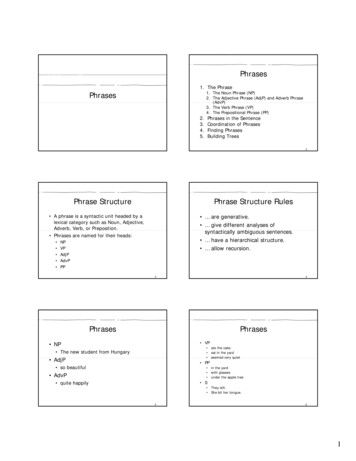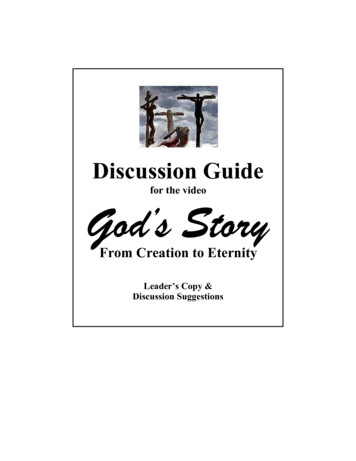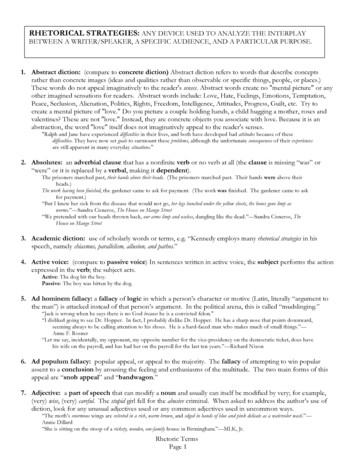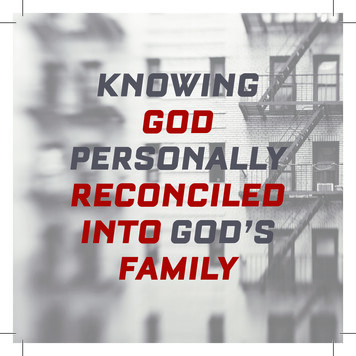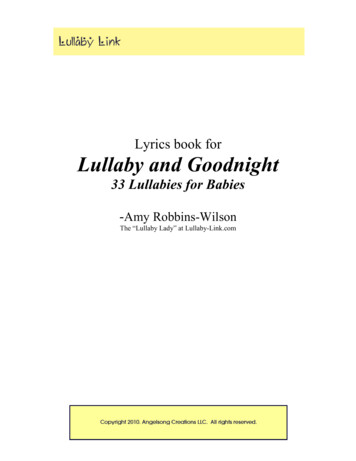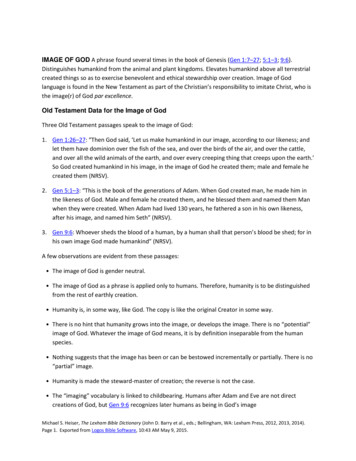
Transcription
IMAGE OF GOD A phrase found several times in the book of Genesis (Gen 1:7–27; 5:1–3; 9:6).Distinguishes humankind from the animal and plant kingdoms. Elevates humankind above all terrestrialcreated things so as to exercise benevolent and ethical stewardship over creation. Image of Godlanguage is found in the New Testament as part of the Christian’s responsibility to imitate Christ, who isthe image(r) of God par excellence.Old Testament Data for the Image of GodThree Old Testament passages speak to the image of God:1. Gen 1:26–27: “Then God said, ‘Let us make humankind in our image, according to our likeness; andlet them have dominion over the fish of the sea, and over the birds of the air, and over the cattle,and over all the wild animals of the earth, and over every creeping thing that creeps upon the earth.’So God created humankind in his image, in the image of God he created them; male and female hecreated them (NRSV).2. Gen 5:1–3: “This is the book of the generations of Adam. When God created man, he made him inthe likeness of God. Male and female he created them, and he blessed them and named them Manwhen they were created. When Adam had lived 130 years, he fathered a son in his own likeness,after his image, and named him Seth” (NRSV).3. Gen 9:6: Whoever sheds the blood of a human, by a human shall that person’s blood be shed; for inhis own image God made humankind” (NRSV).A few observations are evident from these passages: The image of God is gender neutral. The image of God as a phrase is applied only to humans. Therefore, humanity is to be distinguishedfrom the rest of earthly creation. Humanity is, in some way, like God. The copy is like the original Creator in some way. There is no hint that humanity grows into the image, or develops the image. There is no “potential”image of God. Whatever the image of God means, it is by definition inseparable from the humanspecies. Nothing suggests that the image has been or can be bestowed incrementally or partially. There is no“partial” image. Humanity is made the steward-master of creation; the reverse is not the case. The “imaging” vocabulary is linked to childbearing. Humans after Adam and Eve are not directcreations of God, but Gen 9:6 recognizes later humans as being in God’s imageMichael S. Heiser, The Lexham Bible Dictionary (John D. Barry et al., eds.; Bellingham, WA: Lexham Press, 2012, 2013, 2014).Page 1. Exported from Logos Bible Software, 10:43 AM May 9, 2015.
The image of God is described with the language of plurality (“Let us make our image”).The data can be addressed in two lines of inquiry:1. What the image of God means and does not mean.2. How the language of plurality is best parsed to inform the meaning of the image.Problematic Interpretations of the Image of GodThe Image of God Refers to External, Visible Form. The view that “Image of God” refers to external,visible form was predominate beginning in the 1940s due to Gunkel’s commentary on Genesis and anarticle by Humbert. The four basic arguments for this interpretation are:1. “Image of God” is a translation of the prepositional phrase ( ְּב ֶצ ֶלם betselem) (preposition[ ב , b]appended to the Hebrew noun [ ֶצ ֶלם , tselem]. [ ֶצ ֶלם , tselem] occurs in 2 Kgs 11:18; Num 33:52;Ezek 7:20; 16:17 for idols, statues, and figurines). In view of the visual referent of ( ֶצ ֶלם , tselem),Genesis 1:26 may have informed readers that human form was similar to the deity’s own form(Humbert, 153–175; Gunkel).2. In Genesis 5:1–3, Seth was born “according to the image” of his father, Adam. The phrase used inthis instance is ( ְּכ ֶצ ֶלם , ketselem). The Hebrew preposition differs from the phrase in Gen 1:26,having the preposition ( כ , k) instead of ( ב , b). These two prepositions, used with ( ֶצ ֶלם , tselem), areinterchangeable. The two prepositions ( ב , b, “in”; כ , k, “according to”) are interchanged with thenoun ( ֶצ ֶלם , tselem) and the other noun used in Gen 1:26 (“likeness,” ְּדמּות , demuth).It is argued that the meaning of ( ֶצ ֶלם , tselem) is to be informed by ( ְּדמּות , demuth), “likeness.” Thelatter refers to visual likeness or shape, so the former must as well (Ezek 1:10; 1:22; 10:22; Dan 10:16).This argument presumes a synonymy between the two nouns:“in our image, according to מּותנּו ֵ ( ְּב ַצ ְּל ֵמנּו ִּכ ְּד betsalmenuGen 1:26our likeness”kidmuthenu)“in his image, in the image ofGod” ֹלהים ִּ ְּב ַצ ְּלמֹו ְּב ֶצ ֶלם ֱא Gen 1:27Michael S. Heiser, The Lexham Bible Dictionary (John D. Barry et al., eds.; Bellingham, WA: Lexham Press, 2012, 2013, 2014).Page 2. Exported from Logos Bible Software, 10:43 AM May 9, 2015.
(betsalmo betselem elohim)“in the likeness of God” ֹלהים ִּ ( ִּב ְּדמּות ֱא bidmuthGen 5:1elohim)“in his likeness, according to his ( ִּב ְּדמּותֹו ְּכ ַצ ְּלמֹו bidmuthoimage”ketsalmo)Gen 5:3“in the image of God”Gen 9:6 ֹלהים ִּ ( ְּב ֶצ ֶלם ֱא betselemelohim)3. Physical resemblance has something to do with the image in Gen 5:1–3, since the language concernsthe physical offspring of Adam. The expression in Gen 1:26 could be viewed in the same way(Gunkel, Genesis, 112).4. Humanity’s creation in the image of God may be described in those terms as a basis for the Israeliterejection of making images of their God. Making a graven image is prohibited because humanityalready is such an image (Exod 20:4; the word is not [ ֶצ ֶלם , tselem] in this passage).This view began to lose consensus with the publication of an article by Clines. ( ֶצ ֶלם , tselem) is notalways used to speak of a physical object. It can be used metaphorically, to speak of nonconcreteobjects or attributes (Psa 39:7; 73:20). The most explicit Semitic parallels (for example, Akkadian tsalmu)are also used metaphorically (Clines, “The Image of God in Man,” 74–75; Bray, “The Significance of God’sImage in Man”). In the case of Psa 73:20, a vague notion of “shape” is still present, though not inconcrete terms. ( ֶצ ֶלם , tselem) may speak of some type of “representation” of God without saying thatthe thing represented (God) must also be concrete or physical (Westermann, Genesis 1–11, 150). This isparallel with John 4:24, which affirms that God has no body, an idea suggested in Isa 31:3 as well.Anthropomorphisms in the Old Testament also do not argue for understanding God as concrete.Anthropomorphism uses embodied humanity as an analogy toward understanding God. AssumingYahweh has a physical form requires an explanation for why humanity was created with genders thathave absolute physical differences. Rather than enforcing the idea that God inherently possessesMichael S. Heiser, The Lexham Bible Dictionary (John D. Barry et al., eds.; Bellingham, WA: Lexham Press, 2012, 2013, 2014).Page 3. Exported from Logos Bible Software, 10:43 AM May 9, 2015.
physical form, when Yahweh appears to men in human form, there is no suggestion that this form isanything but a temporary manifestation (Clines, “The Image of God in Man,” 72).Yahweh occasionally assumes a human form in the Old Testament (Gen 18; Exod 24:9–18; Deut4:12; Ezek 1:26). He is not depicted in human terms because He has a body, but because He is a person.In Israelite thinking, it was impossible to think clearly about personhood without thoughts ofembodiment. The Hebrew Bible describes a person in terms of the fusion of material flesh andimmaterial inner life (Johnson, The Vitality of the Individual).Recent scholarship has noted logical weaknesses in the idea that “likeness” ( ְּדמּות , demuth)requires “image” ( ֶצ ֶלם , tselem) to be understood in visual terms. Since the terms are not always paired,it cannot be said that one is necessary to communicate the other. It also suggests that their meaningsare not completely synonymous.Clines argued that variation between the prepositions and nouns might have deliberate intent andcommunicate something about the meaning of the image of God: “When the reference is to the imageof God and not to Adam’s image (Gen 5:3), the preposition with ( ֶצ ֶלם tselem) is always ְְּּ ( ב b). This couldbe accidental, but we suggest that it is not. Genesis 5:1 and 5:3 do not speak of the transmission of thedivine image (for it belongs to man as such, and so cannot be transmitted ) but of Seth’s likeness toAdam. Adam was made ‘in the likeness’ (which is the same thing as ‘according to the likeness’) of God.Thus verse 1 has ( בדמות bdmwt), and not ( בצלם btslm). Seth is not Adam’s image, but only likeAdam’s shape; so verse 3 has not ( בצלמו btslmw), but ( כצלמו ktslmw). Thus, Genesis 1:26 is not tobe interpreted by Gen 5:1, 3, but vice versa” (Clines, “The Image of God in Man,” 78n117).There does not appear to be any secure exegetical link between Gen 1:26 and Exod 20:4. Thevocabulary differs, and the commandment fails to ground the prohibition in the narrative abouthumankind’s creation.The Image as a Physical Attribute. The image of God is often defined as an ability dependent on thehuman brain, including: Intelligence Rationality Emotions Volitional will ConsciousnessMichael S. Heiser, The Lexham Bible Dictionary (John D. Barry et al., eds.; Bellingham, WA: Lexham Press, 2012, 2013, 2014).Page 4. Exported from Logos Bible Software, 10:43 AM May 9, 2015.
Sentience The ability to communicate.Many of these options are coherent, but defining the image of God in any of these ways failsexegetically and creates a problem for beginning of life and end of life ethics: All are not equally present among all human beings. All are not present in all human beings at all times. Some are not unique to human beings.For example, the fertilized human embryo does not possess these abilities or attributes. To an embryo,they are potential attributes. If the image of God is said to be any of these things, the human onlypotentially bears the divine image until those attributes are possessed. This means that one must eitherdeny the human personhood of the embryo or produce a more coherent alternative for defining theimage of God. Even after birth, these options would mean that a severely retarded or brain-damagedchild does not bear the divine image. Such definitions, if held consistently, would result in the loss of theimage for some human beings.Scientific and psychological research question whether some of these attributes are unique tohumans. In regard to intelligence, the field of animal cognition has demonstrated that many animalshave intelligence that cannot be assigned merely to instinct (Griffin, Animal Thinking; Pearce, AnimalLearning and Cognition). For example, the ability to remember instructions or act contrary to instinctconstitutes intelligence. Several species of mammals and birds score higher on simple intelligence teststhan human infants or toddlers. Animals have been shown to grieve as well, so human emotion is notunique. Animals also show the ability to communicate (Savage-Rumbaugh, “Language Learning in TwoSpecies of Apes”).Scripture gives no indication that the divine image is bestowed incrementally or intermittently, anddemands that the image must be unique to humans with respect to creation.The Image of God as the Immaterial Nature of Humans. Humanity’s inner or “spiritual” nature mayoffer a better strategy for defining the image of God.Spiritual Abilities. “Spiritual abilities” are “God-directed” abilities or spiritual inclinations of the innerlife. Examples include: The belief in God A desire to know God Prayer Knowing right from wrongMichael S. Heiser, The Lexham Bible Dictionary (John D. Barry et al., eds.; Bellingham, WA: Lexham Press, 2012, 2013, 2014).Page 5. Exported from Logos Bible Software, 10:43 AM May 9, 2015.
These abilities require cognition. As with the physical abilities that require brain function, spiritualabilities or desires are not possessed equally by all humans. Furthermore, some animals may possessmoral awareness (Putz, “Moral Apes”; Griffin, Animal Minds).The faculty of knowing right from wrong is specifically denied as being part of the image of God.Scripture is clear that this sort of moral awareness only came about after humanity’s creation in God’simage, not in association with it. As Bray points out: “[C]onferred moral awareness is directlycontradicted by the narrative in Genesis itself. It is extraordinary that this was never recognized, yet it isplain for all to see that Adam, though he was created in the image of God, was not allowed to eat of thetree of the knowledge of good and evil. When he did so, God said ‘Behold, the man has become like oneof us,’ implying that in this particular at least, there had been an important dissimilarity betweenHimself and His human creature” (Bray, “The Significance of God’s Image in Man,” 207).The “Soul”. The image of God may refer to the possession of a soul or spirit. The ancient Israelitebelieved that a person was the totality of the body and the inner, animate life force. They were notinclined to define the “parts” of humanity.The Old Testament terms for “soul” ( נֶ ֶפׁש , nephesh) and “spirit” ( רּוח , ruch) are consistently usedto identify that the body is living or attributes dependent on brain function, such as emotions andintelligence. The terms are used interchangeably. Scripture never speaks to the origin of the immaterialpart of humans, save for the account in Genesis where God animates the first human, Adam, bybreathing into him the “breath ( ׁש ַמת ְּ ִּ נ , nishmath) of life” (Gen 2:7; Josh 11:11). Animals are describedas having the “soul” ( נֶ ֶפׁש , nephesh) and “spirit” ( רּוח , ruch) (Gen 1:21, 24; Eccl 3:21). “Breath”( ׁש ַמת ְּ ִּ נ , nishmath) is also interchangeable with “soul” ( נֶ ֶפׁש , nephesh) and “spirit” ( רּוח , ruch). Theterms also overlap in usage with “heart” ( ֵל ָבב , levav/ ֵלב , lev). A sampling of the biblical terminologyand its usage:1. The life force/that which animates the body1. ( נֶ ֶפׁש , nephesh)—Gen 1:20–21, 24, 30; 9:4–5; 12:13; 19:19; 35:18; Exod 4:19; Job 11:20; 33:22;33:28; 33:302. ( רּוח , ruch)—Gen 6:17; 7:15, 22; 45:27; Zech 12:1; Psa 135:17; Job 7:7Michael S. Heiser, The Lexham Bible Dictionary (John D. Barry et al., eds.; Bellingham, WA: Lexham Press, 2012, 2013, 2014).Page 6. Exported from Logos Bible Software, 10:43 AM May 9, 2015.
3. Both terms are combined with “breath” ( ׁש ַמת ְּ ִּ נ , nishmath) to convey this idea as well:( ׁש ַמת ְּ ִּ נ , nishmath) ( רּוח , ruch) (Gen 7:22; Job 27:3; 32:8; Isa 42:5; 57:16); ( נִּ ְּׁש ַמת ,nishmath) ( נֶ ֶפׁש , nephesh) (Gen 2:7; Josh 11:11)2. The “inner life” of a person1. The seat of emotions2. ( נֶ ֶפׁש , nephesh)—Lev 26:15; 30, 43; Jer 13:17; 14:19; Lam 3:17; Gen 34:3, 8; 42:21; Exod 15:19;23:19; Num 21:4; 1 Sam 1:10, 15; 2 Sam 5:8; 17:8; 2 Kgs 4:27; Job 14:22; Pss 6:3; 13:2; 23:3;35:25; 42:1–23. ( רּוח , ruch)—Num 5:14; 5:30; Eccl 10:4; 2 Chr 18:22; Isa 54:6; 57:15; Prov 14:294. ( ֵל ָבב , levav/ ֵלב , lev)—Gen 6:6; Gen 34:3; Judg 16:25; 1 Kgs 21:7; 2 Kgs 6:115. Internal dispositions, attitudes, and abilities6. ( נֶ ֶפׁש , nephesh)—Lev 26:16; Judg 16:16; 1 Sam 2:33; Pss 42:6; 107:26; Deut 4:29; 6:5; 10:12;11:13; 11:18; 14:26; 21:14; 23:24; 1 Sam 23:20; Prov 19:2;7. ( רּוח , ruch)—Isa 19:3; 29:24; 57:15; 61:3; Jer 10:14; 51:11, 17; Hag 1:14; Pss 34:19; 51:19;76:12; Job 32:18; Prov 15:13; 16:19; 17:22, 27; 18:14; 29:23; Ezra 1:1; Exod 6:9; Num 14:24; Josh2:11; 5:1; Ezek 11:19; 18:31; 21:12; 36:26; Eccl 7:8; Dan 5:12; 6:4; 1 Chr 28:12Michael S. Heiser, The Lexham Bible Dictionary (John D. Barry et al., eds.; Bellingham, WA: Lexham Press, 2012, 2013, 2014).Page 7. Exported from Logos Bible Software, 10:43 AM May 9, 2015.
8. ( ֵל ָבב , levav/ ֵלב , lev)—Gen 6:5; 8:21; 31:20; 42:28; 1 Sam 10:26; 17:32; 24:6; 2 Sam 15:13;24:10; Exod 28:3; 35:34; 31:6; Num 16:28; Ezek 13:1–3; 1 Kgs 3:9; 2 Kgs 12:5; Eccl 1:16; 2:10; 1Chr 12:34; Psa 12:3; Lam 3:33Hebrews 4:12 refers to the Word of God’s ability to “divide the soul and spirit,” but this does not pointto an actual division of those two terms—it claims the word of God could penetrate the inner person insuch a way, not that such a division already exists before the word of God works its power. The point isactually the hard fusion of the two, separable only by the supernatural empowerment of the word ofGod. As in the Old Testament, soul and spirit are two ways of referring to the same immaterial nature. 1Thess 5:23 may support a separation: “Now may the God of peace himself sanctify you completely, andmay your whole spirit and soul and body be kept blameless at the coming of our Lord Jesus Christ.” Paulis probably expressing his wish for believers to be sanctified as completely as possible. He uses the wordὁλοτελής (holotelēs) to express his wish for complete sanctification, a term that means “in every waycomplete.” Although Scripture is clear that humans have an immaterial existence outside the body atdeath (2 Cor 5:8), that reality cannot be decisively connected to any biblical term for the inner life.The Meaning of the Image of GodA more coherent understanding can be found by appeal to Hebrew syntax with respect to theprepositional phrase ( ְּב ֶצ ֶלם betselem). The preposition ( ב , b) should be understood as what Hebrewgrammarians variously refer to as: The “beth of essence (beth essentiae) or equivalence” (Joüon and Muraoka, A Grammar of BiblicalHebrew, 2:487). The “beth of identity” (Waltke and O’Connor, An Introduction to Biblical Hebrew Syntax, 198). The “beth of predication” (Gordon, “ ‘In’ of Predication or Equivalence,” 612–13).The preposition “in” should be understood as meaning “as” or “in the capacity of.” Humanity wascreated “as” the image of God. The concept can be conveyed if we think of “image” as a verb: Humansare created as God’s imagers—they function in the capacity of God’s representatives. The image of Godis not a quality within human beings; it is what humans are. Clines summarizes: “What makes man theimage of God is not that corporeal man stands as an analogy of a corporeal God; for the image does notprimarily mean similarity, but the representation of the one who is imaged in a place where he is not. According to Gen 1:26ff, man is set on earth in order to be the representative there of the absent Godwho is nevertheless present by His image (Clines, “The Image of God in Man,” 87)”Every human, regardless of the stage of development, is an imager of God. There is no incrementalor partial of the image via some ability, physical or spiritual. No member of the animal kingdom,Michael S. Heiser, The Lexham Bible Dictionary (John D. Barry et al., eds.; Bellingham, WA: Lexham Press, 2012, 2013, 2014).Page 8. Exported from Logos Bible Software, 10:43 AM May 9, 2015.
regardless of any cognitive ability it might have, is an imager of God. The same goes for any intelligentlife form, artificial or the hypothetical extraterrestrial.This understanding lends clarity to the Old Testament passages. Being created as God’s imagersmeans we are His representatives on earth—the only qualification for this is that we are human. This iswhy the creation of humankind as God’s image in Gen 1:26–27 is immediately followed by the so-calleddominion mandate of Gen 1:28. Humanity is tasked with stewarding God’s creation as though God werephysically present to undertake the duty himself. Genesis 9:6’s requirement of capital punishment formurder is because the intentional killing of an innocent human was tantamount to killing God in effigy.Clines argument with respect to Gen 5:1–3 is also brought into sharper focus: “Seth is not Adam’s image,but only like Adam’s shape” (Clines, “The Image of God in Man,” 78n117). Seth resembled Adam, but hewas not Adam’s representative on earth. The prepositional changes in Gen 5 serve to distinguish thepoint of Gen 1:26–27 from Gen 5:1–3.This view means that all human endeavor and enterprise has spiritual meaning—work is a spiritualexercise. Vocation is worship, no matter how mundane. Any task performed to steward creation, toharness its power for God’s glory and the benefit of fellow imagers, and to foster in the harmoniousproductivity of fellow imagers, is imaging God. This application of the image has been referred to as the“cultural mandate” or the vocational view of the imago Dei (Sands, “The Imago Dei as a Vocation”).The Plural Language Associated with the Image of GodProblematic Interpretations of the Plurality. The plurality in the expression “let us create humankind inour image” may points to plurality within God. Christians see the Trinity in this language. However, anancient Israelite or Jew never would have presumed this (Wenham, Genesis 1–15, 27–28; Hamilton, TheBook of Genesis, 133–34). This option reads the New Testament back into the Old—the language doesnot specify (or limit) the plurality to three persons. The Old Testament uses the language of divineplurality in contexts that, were the Trinity to be imported into the passage, would result in its membersbeing corrupt and wicked (Psa 82; Heiser, “Monotheism, Polytheism, Monolatry, or Henotheism?”).Plurality may be an example of the “plural of majesty,” a grammatical use of the plural to point to “afullness of attributes and powers” (Wenham, Genesis 1–15, 28). However, the plural of majesty is notused with pronouns or verbal forms, the latter of which is present in Gen 1:26 and 11:7.In reference to Isaiah 6:8, the plural language in Gen 1:26 may be a self-deliberation or selfencouragement. This perspective is akin to the “editorial we.” The plurality describes how peopledeliberate with themselves. However, it is difficult to see how this view can work with the meaning ofthe image as God’s representative. It is also difficult to cohere this view with Psa 8, in which humanity issaid to have been created a little lower than elohim (Psa 8:5). That the word elohim is to be taken as aplural is evident from its citation in Heb 2:7, where the writer quotes the passage from the Septuagint,which renders elohim as “angels.”Michael S. Heiser, The Lexham Bible Dictionary (John D. Barry et al., eds.; Bellingham, WA: Lexham Press, 2012, 2013, 2014).Page 9. Exported from Logos Bible Software, 10:43 AM May 9, 2015.
Some look to humanity as the referent of the plurality. Bray writes, “A more awkward question israised by the use of the plural in Gen 1:26, implying as it does that man, as the image of God, somehowreflects a plurality in God” (Bray, “The Significance of God’s Image in Man,” 197).An Announcement to the Heavenly Host. In Genesis 1:26, God, the lone speaker, is probablyannouncing His intention to create humankind to the members of His heavenly host (Psa 82; 89:5–8).Wenham writes, “From Philo onward, Jewish commentators have generally held that the plural is usedbecause God is addressing his heavenly court” (Wenham, Genesis 1–15, 27).As humans, we use this sort of language with regularity. A mother could announce to her family,“let’s make dinner”—and then proceed to do so herself, for their benefit, without their involvement inthe event. This is more coherent than a mere rhetorical self-reference since it involves the audience,though without necessarily requiring their active participation. This is also the most coherentexplanation for the other plurality language we have touched upon (Gen 11:7; Isa 6:8). God among hisheavenly host is a familiar biblical description (Deut 33:1–2; Psa 68:17; 1 Kgs 22:19–23).Bray notes: “More probable is the idea that God is here speaking to the heavenly hosts, though thisraises such questions as whether angels are also created in the image of God, whether angels took partin the work of man’s creation” (Bray, “The Significance of God’s Image in Man,” 198). Clines asserts thatthis view “would imply that man was made in the image of the elohim as well as of God Himself (‘in ourimage’); it would mean that the elohim shared in the creation of man (‘let us make’)” (Clines, “The Imageof God in Man,” 66).The text is clear that the angels did not participate in the creation of humankind. The singular suffix(“so God created humankind in His image”) makes that point as well. There is no contradiction if “let uscreate” is taken as an announcement of the single Creator to a group.Angelic beings are also divine imagers—representatives of their Creator. While humans image Godon earth, angelic beings image God in the spiritual world. They do God’s bidding in their own sphere ofinfluence. The Old Testament and New Testament describe angelic beings with administrativeterminology, such as: “Prince” (Dan 10:13, 20–21) “Thrones” (Col 1:16) “Rulers” (Eph 3:10) “Authorities” (1 Pet 3:22; Col 1:16)First Kings 22:19–23 illustrates the heavenly bureaucracy at work. Angelic beings were created beforethe earth, and therefore before humans (Job 38:7–8). The notion that God decided to make humans torepresent Him and His will on earth mirrors what God had already done in the spiritual world. Godannounces that, as things are in the heavenly realm, so they will be on earth. Humanity is lesser thanMichael S. Heiser, The Lexham Bible Dictionary (John D. Barry et al., eds.; Bellingham, WA: Lexham Press, 2012, 2013, 2014).Page 10. Exported from Logos Bible Software, 10:43 AM May 9, 2015.
angelic beings. However, humans are not their representatives, but are destined to rule over angels andto inherit the nations ruled by some of the sons of God (1 Cor 6:3; Rev 2:26).The Image of God in the New TestamentThe functional view of the image described argues that the phrase means humans are created as God’simage. Taking that understanding to the New Testament’s image of God language brings the meaningand importance of the image doctrine in New Testament theology into clear focus.Paul argues that believers are destined to be conformed to the image of Christ (Rom 8:29). We areto live as God would, to represent him and his character. Paul elsewhere refers to Jesus as the image ofGod (2 Cor 4:4). The writer of Hebrews uses the same verbiage, calling Jesus “the express image of God”(Heb 1:3). As humans gave visible form to God, so Jesus is the image of the invisible God (Col 1:15). Jesuswas truly incarnate, becoming human to atone for humankind, but also an example for humankind (Phil2:6–10; 1 Pet 2:21).These New Testament passages convey that Jesus was the imager of God. As Jesus imaged God, wemust image Jesus. In so doing, we fulfill the rationale for our creation. This process is gradual: “And weall, with unveiled face, beholding the glory of the Lord, are being transformed into the same image fromone degree of glory to another. For this comes from the Lord who is the Spirit” (2 Cor 3:18). Paul alsolinks our resurrection to Jesus as the image of God in 1 Cor 15:49.BibliographyBeauregard, Mario, and Sue O’Leary. The Spiritual Brain: A Neuroscientist’s Case for the Existence of theSoul. New York: Harper One, 2007.Bray, Gerald. “The Significance of God’s Image in Man.” Tyndale Bulletin 42:2 (1991).Clines, D. J. A. “The Image of God in Man.” Tyndale Bulletin 19 (1968): 53–103.Foerst, Anne. “Cog, a Humanoid Robot, and the Question of the Image of God.” Zygon: Journal ofReligion and Science 33 (1998): 91–111.Gordon, Cyrus.” ‘In’ of Predication or Equivalence.” Journal of Biblical Literature 100 (1981): 612–13.Green, Joel, and Stuart Palmer, eds. In Search of the Soul: Four Views of the Mind-Body Problem.Downers Grove: InterVarsity Press, 2005.Grenz, Stanley. “Jesus as the Imago Dei: Image of God Christology and the Non-Linear Linearity ofTheology.” Journal of the Evangelical Theological Society 47:4 (Dec 2004).Griffin, Donald R. Animal Thinking. Cambridge: Harvard University Press, 1985.Griffin, Donald R. Animal Minds: Moving Beyond Cognition to Consciousness. Chicago: University ofChicago Press, 2001.Michael S. Heiser, The Lexham Bible Dictionary (John D. Barry et al., eds.; Bellingham, WA: Lexham Press, 2012, 2013, 2014).Page 11. Exported from Logos Bible Software, 10:43 AM May 9, 2015.
Gunkel, H. Genesis. Göttingen: Vandenhoeck and Ruprecht, 1964.Hamilton, Victor P. The Book of Genesis: Chapters 1–17. New International Commentary on the OldTestament. Grand Rapids: William B. Eerdmans. 1990.Heiser, Michael S. “Monotheism, Polytheism, Monolatry, or Henotheism? Toward an Assessment ofDivine Plurality in the Hebrew Bible.” Bulletin for Biblical Research 18:1 (2008).Herzfeld, Noreen. “Creating in Our Own Image: Artificial Intelligence and the Image of God,” Zygon:Journal of Religion and Science 37:2 (2002).Humbert, P. Etudes sur le récit du paradis et de la chute dans la Genèse. Secrétariat de l’Université:Neuchâtel, 1940.Jackelén, Antje. “The Image of God as Techno Sapiens.” Zygon: Journal of Religion and Science 37:2(2002): 289–302.Johnson, Aubrey R. The Vitality of the Individual in the Thought of Ancient Israel. Cardiff: University ofWales Press, 1964.Joüon, Paul, and Takamitsu Muraoka. A Grammar of Biblical Hebrew. 2 vols. Editrice Pontificio IstitutoBiblico, 2003.O’Meara, Thomas F. “Christian Theology and Intelligent Extraterrestrial Life.” Theological Studies 60:1(1999).Overstreet, R. Larry. “Man in the Image of God: A Re-Appraisal.” Criswell Theological Review 3:1 (Fall2005): 43–70.Pearce, John M. Animal Learning and Cognition. 3rd ed. Psychology Press, 2008.Peters, Ted. “The Implications of the Discovery of Extraterrestrial Life for Religion.” PhilosophicalTransactions of the Royal Society 369 (2011): 499–507.Putz, Oliver. “Moral Apes, Human Uniqueness, and the Image of God.” Zygon: Journal of Religion andScience 44:3 (2009): 613–24.Sands, Paul. “The Imago Dei as Vocation.” Evangelical Quarterly 82:1 (2010): 28–41.Savage-Rumbaugh, Sue, Duane M. Rumbaugh, and Kelly McDonalds. “Language Learning in Two Speciesof Apes.” Neuroscience and Biobehavioral Reviews 9 (1985): 653–65.Waltke, Bruce K., and M. O’Connor. An Introduction to Biblical Hebrew Syntax. Winona Lake, Ind.:Eisenbrauns, 1990.Wenham, Gordon J. Genesis 1–15. Word Biblical Commentary 1. Dalla
2. Gen 5:1-3: This is the book of the generations of Adam. When God created man, he made him in the likeness of God. Male and female he created them, and he blessed them and named them Man when they were created. When Adam had lived 130 years, he fathered a son in his own likeness, after his image, and named him Seth (NRSV). 3.
